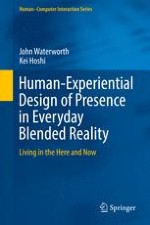2016 | OriginalPaper | Buchkapitel
5. Bridging Contextual Gaps with Blended Reality Spaces
verfasst von : John Waterworth, Kei Hoshi
Erschienen in: Human-Experiential Design of Presence in Everyday Blended Reality
Aktivieren Sie unsere intelligente Suche, um passende Fachinhalte oder Patente zu finden.
Wählen Sie Textabschnitte aus um mit Künstlicher Intelligenz passenden Patente zu finden. powered by
Markieren Sie Textabschnitte, um KI-gestützt weitere passende Inhalte zu finden. powered by
